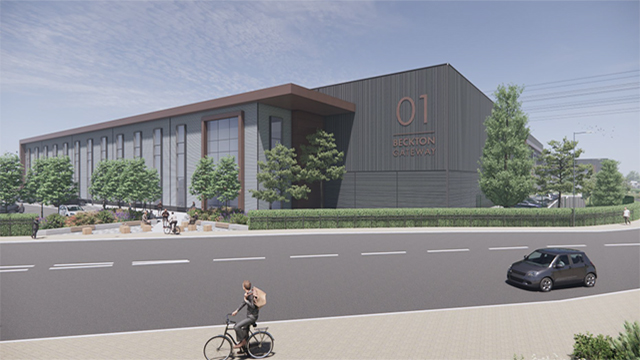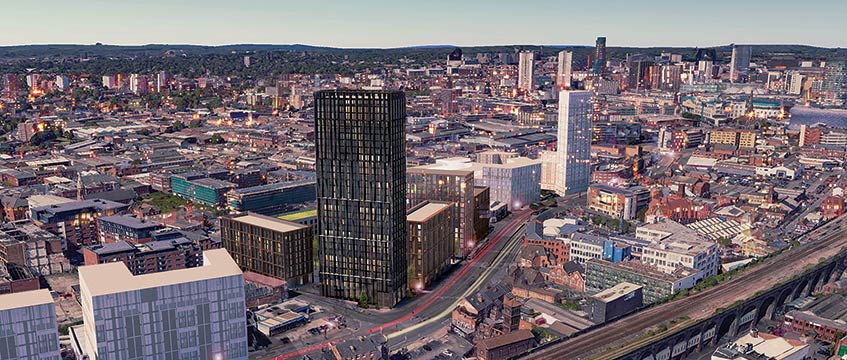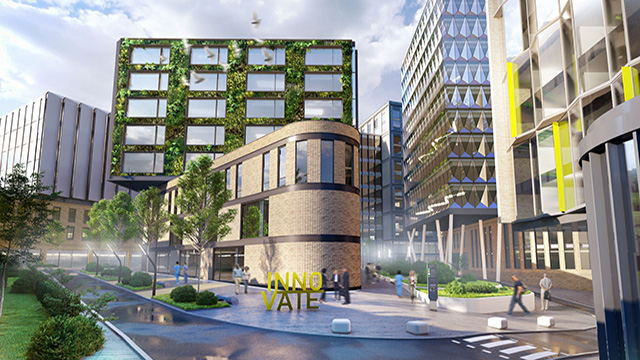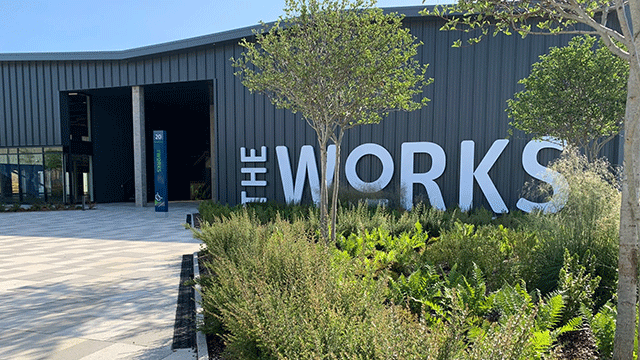Michael Foster
If or when people get round to writing the history of the 1987 property share boom, there is little doubt that they should regard Randsworth Trust as a company out to make the most of its opportunities.
Courtesy of massive stock market and banking support, its new bosses, David Holland (right) and Andrew Nichols, have turned it from a little plant hire company making profits of under £22,000 in 1985-86 into a £90m combine capable of taking over London & Provincial Shop Centres, Apex Properties and a Fisons pension fund portfolio in the last three months.
“They make me look staid,” jokes Mountleigh’s Tony Clegg (impossible, surely?). “They’re brilliant. I just hope they don’t go into orbit,” says one City follower. At the very least, all this activity made a good excuse for David Holland to postpone his trip to the dentist last week.
Randsworth is a former shell company called Kotmalie Valley Tea Estates of Sri Lanka, which fell under the control of Nicholas Langley-Pope and Harry Musaphia in May 1980 via a bid worth 2 1/2p a share. Its sponsor was a little issuing house called Cleves Investment run by former Vehicle & General man Reggie Burr.
Messrs Langley-Pope and Musaphia turned Kotmalie into a plant hire group called Jay-plant, and won it a quote on the Unlisted Securities Market. But by mid-1986 the company was failing to perform well and Messrs Holland (aged 44) and Nichols (45) moved into the saddle.
Mr Holland is a lawyer who passed his bar exams after a Cambridge graduate course in the mid-1970s; he has long specialised in property and planning matters, and became corporate director of J J & D Frost around 1980. Frost has now become a petrol retailing, sales promotion and banking company making pre-tax profits of just under £2m. It has set up the Blue Chip trading stamp empire to rival newly revived Green Shield.
He teamed up with finance man Andrew Nichols some time ago: Mr Nichols is the former finance director of Brixton Estate who left to pursue private interests after a disagreement with chairman Harry Axton in 1985.
Messrs Holland and Nichols joined Jayplant’s board a year ago, and changed its name to Randsworth (the title of its old property division). By June 1986 they had put together a takeover of a litle oil stock called Lorne Exploration managed by Noble & Co of Edinburgh for £1.12m, payable in shares underwritten at 52 1/2p each. More than a fifth of the company was owned by David Holland and Douglas Lowe (an old pal of his from Cambridge, who is now Randsworth deputy chairman).
Liquidation of Lorne put cash into Randsworth. Messrs Holland and Nichols then sold it a 12-maisonette housing development in Barnet (with units now selling at more than £60,000 each), and control of a nursing home which overlooks the cliffs at Bournemouth now managed by Frank Sanderson’s Egerton Trust. A development of five maisonettes at Angmering on Sea also went into the group.
Messrs Holland and Nichols considered buying a travel business called Starvillas and decided against the idea. They also rejected an opportunity to sort out a troubled nursing home operation called Lifecare International (which later went into receivership), but forged a friendly relationship with Lifecare’s broker Laurie Milbank which later became part of Chase Manhattan and Randsworth’s adviser. John Little (ex-managing director of Lloyds & Scottish) later became chairman of Lifecare — and Randsworth too.
None of this needed to have mattered to the stock market at large were it not for the well-timed purchase of an office site at London’s Wilson Street close to Rosehaugh’s Broadgate scheme last year. Randsworth bought it from a Northern Irish building group called Windsor for around £1.4m; a rejigging of a planning permission for around 60,000 sq ft of commercial space and soaring local rents led to agents Richard Saunders valuing it at £5 1/2m last March. Working on potential rents of £30-£40 per sq ft (and assuming an industrial element in the scheme gets turned into offices) the ultimate worth of a completed development would range up to £30m-£40m, including a surplus of £15m-£25m.
Randsworth is likely to fund, or forward sell, the Wilson Street scheme in stages so that the final surplus will accrue to profits in the next couple of years. More important, its handling of the scheme impressed a small fan club of institutions including John Govett, Royal Insurance and Target willing to become Randsworth shareholders and back its expansionary moves. Assets estimates for Randsworth of up to 200p per share helped the market price from 65p to more than 200p early this year; strong support came in from Greenwells the stockbroker. “Randsworth Trust — a star is born?” was the title to “Company File” in Estates Gazette on January 31, before the latest action took place.
By February, Randsworth was working to implement a planning permission for 52,000 sq ft of hi-tech space near Guildford, now likely to let at £10 per sq ft. Postel could end up funding the scheme. At 25-26 Half Moon Street it brought forward plans to build 10 flats for renting (“We don’t want to sell any freeholds in Mayfair,” says Mr Holland).
It also put down a marker on quoted property group Apex Properties by buying a 13% stake, and sent its shares soaring 32p to 125p on bid hopes — quickly dashed (or so we all thought) by Randsworth’s audacious bid for London & Provincial Shop Centres.
LPSC
LPSC is the creation of solicitor Bernard Berrick and surveyor Ron Gerrard, who first joined forces in 1959. Their original plan (as the company’s name suggests) was to build a shop portfolio, though in due course offices became more attractive to them.
The company gained a stock market quote in February 1964; the issue was oversubscribed 20-fold. Within a year it was making pre-tax profits of £21,000, backed by net assets of £280,000.
In succeeding years LPSC built a portfolio of 70 shops, and West End offices. It developed (and sometimes traded) commercial blocks in Southampton, Oxford and Harrogate.
Its main stamping ground became Slough, where its office schemes spread off the High Street and Windsor Road, and totalled around 330,000 sq ft by the early 1980s. LPSC effectively profited from tight planning controls and mastery of practically all the good, new space going up at any one period.
As rents soared towards the mid-teens in Slough, the increasing value of LPSC’s blocks pushed up its net asset backing from around £10m in 1974 to £65m by 1982. LPSC successfully pioneered a campaign to get the arbitration system to recognise that rents on a review period of more than five years deserved a premium on reassessment, and rejigged its leases to a three-to-five-year pattern. It bought in freeholds wherever possible.
After the property crash, the stock market was keen to recognise the property management skills within LPSC and gave its shares a premium rating. LPSC’s interest charges were not always the lowest in the sector for its size, but its rental stream provided excellent underpinning. Rumour suggested that the likes of Nat West pension fund was keen to make an offer for the company at one stage; Legal & General was a firm holder of 16% of the shares, and the directors owned another third.
In 1981, Bernard Berrick became a tax exile in Monte Carlo. Ron Gerrard continued to look after the fort at home, with shrewd day-to-day management staying in the hands of property man Pat Bos and company secretary Vyvyan Rees.
As the 1980s dragged on, other developers came on to the scene at Slough and local rent increases slowed down. LPSC finished the development of the 36,000-sq ft Edinburgh House and the 32,000-sq ft Cornwall House, but lettings there (at around £16 per sq ft) were slow to be finalised. LPSC called a halt to large, new schemes.
Though profits rose to £2.2m by 1985, LPSC’s shares fell back from their high point of 465p in 1981 to a low of 215p by 1986. Valuers Healey & Baker knocked £7.3m off the value of the company’s freeholds in 1985, leading to a reduction of 10% in assets per share. Gearing rose as a result of the development of Edinburgh and Cornwall Houses; when interest on those schemes ceased to be capitalised, pre-tax profits fell sharply to £931,000.
As the Slough office market began to pick up in 1986, and the company completed a successful £15m debenture issue, the stock market began to look for renewed dynamism from Messrs Gerrard and Berrick. They announced plans for a £12,600-sq ft extension to Edinburgh House, bought-in the quarter share of Cornwall House they did not already own and purchased a freehold in Horsham.
Fair price
Michael Kent (former boss of development trader M P Kent, now owned by C H Beazer) recognised potential in LPSC early this year by buying a 5% stake. Whether or not he was interested in making a bid is immaterial, because signals soon began to go round the property market that control of the company might be available to anyone prepared to pay a full and fair price.
Over at Randsworth’s temporary headquarters in Half Moon Street, David Holland’s sensitive antennae started flashing. He cobbled together as much background information on LPSC as he could, and jetted off to see Bernard Berrick in Monte Carlo.
What Mr Holland wanted to do was use Randsworth’s strong share price to buy solid assets which would allow him to finance the Wilson Street deal, and other grand plans for growth — including the possible takeover of Apex Properties.
He was able to get Randsworth’s share price successfully underwritten by Chase Manhattan to wheel out an offer of 325p cash for every LPSC share — against a 350p asset backing.
An alternative paper bid led to the offer of nine Randsworth shares for every four LPSC, working out at 335p with Randsworth’s share price falling back to 149p after news of the approach broke.
The whole deal lifted Randsworth’s net asset backing to £67m (134p a share) after taking account of the Wilson Street site valuation surplus — before the deal, Randsworth’s net assets were £10m (73p a share). Those figures, plus the expertise of Messrs Holland and Nichols and potential extra cash at Wilson Street, encouraged Randsworth’s fan club and underwriters to endorse the deal.
Messrs Berrick and Gerrard took an option on the lease of LPSC’s headquarters at 28 South Street, valued at £390,000 by Healey & Baker. Otherwise, their relations with LPSC are at an end, and Randsworth took over management control about a fortnight ago.
It is early days to assess what will happen to LPSC’s properties. Some of them will be shunted on to third parties and the future of a potential 70,000-sq ft refurbishment of Key West House, Slough, reviewed. Newly rising rents in Slough (currently £17.50 per sq ft) give Randsworth extra room for manoeuvre.
Apex Properties
Less than a month after the LPSC deal was announced, Randsworth was flexing its muscles again at Apex Properties via the purchase of a further 5.8% stake from Jersey property man David Kirch, who recently hit the local headlines after pleading guilty to a technical offence relating to his takeover of fast-growing Channel Hotels & Properties in the early 1980s.
That Kirch purchase added momentum to talks which Randsworth had been having with Apex for some time; it spotted potential in this quiet little company run by a keen farmer called John de Vere Hunt, where few had seen any.
Following the LPSC takeover, Randsworth’s balance sheet was strong enough to finance the takeover of Apex for 135p in cash, valuing it at £14 1/2m. The de Vere Hunt family controlled 62 1/2% of the company, and accepted the bid with both hands.
The principal assets of Apex are two office blocks in New Malden. One of them — the 96,000-sq ft Coombe Tower — has been slow to let, and brought down the rating of Apex in the stock market quite severely in recent years despite buying by Courtaulds pension fund. From a high of 175p in 1981, Apex’s share price tracked down to a low of 69p in 1986. The company has shown heavy losses for two years; a massive write-off against Coombe took net assets down to £6.9m (63p a share) last year.
Randsworth has started remarketing Coombe with renewed vigour (and the appointment of Clive Lewis & Partners as new letting agents). Almost half the block should soon be occupied. Rents, historically ranging from around £10.50 to £11.50, should soon be stepped up another pound or so; there is additional potential in a small commercial annexe to Coombe.
Longer term there must be scope for Randsworth to negotiate some sort of deal with the Church Commissioners who have a big share in Coombe’s twin Apex Tower, let to the likes of the Department of the Environment.
Potential in the rest of Apex’s portfolio should not be neglected. It includes two shops in Sloane Street; two shops in Notting Hill Gate; an office block in Romford Road, London E7, totalling 36,000 sq ft; a bakery in Twickenham near the M3; and 100,000 sq ft of industrial space in Worksop. Those all take up a fair chunk of Apex’s net assets of £12m, which (on letting Coombe) could be worth a great deal to Randsworth. After the Apex deal its book net assets were £60 1/2m (120p a share).
While they were in the fast lane, Messrs Nichols and Holland were loath to slow down. Within weeks, they had clinched the purchase of a property portfolio from Fisons pension fund for £7 3/4m, to provide them with an extra source of trading profits in the year ahead.
The Fisons properties were too small individually to matter to the pension fund. The deal was sniffed out by Tony Kempner — a man with good connections in the world of pension funds — who is a Randsworth non-executive. He and Tony Brayford — former development man with Brixton Estate — provide an important dimension to the Randsworth management team.
The properties include shops in Ipswich (round the corner from some LPSC holdings), Norwich and Bury St Edmunds; commercial property at Maidenhead and West Bromwich (let at £1.50 per sq ft); a cash-and-carry at Hull; an MFI warehouse at Colchester; and two car parks whose rent is linked to construction costs. They could be sold on at a surplus for Randsworth of £2m, given a fair wind.
Potential profits
The upshot of all this is that Randsworth could have a potential net asset backing of up to £100m (200p a share) and gearing of 50-60%. Potential profits, according to Greenwell, are £5m, indicating a high earnings multiple of 26.
Expect early moves by Randsworth to pin down its interest rate costs via a debenture or some such device. Talks are proceeding with a trading company to take on at least some of its property management along lines recently agreed between Rosehaugh and Woolworth. Medium-sized schemes are under negotiation.
Randsworth can now be included with mighty Mountleigh, Chase Property (formerly Wingate), Imry International, Local London, Gilbert House, Priest Marians, Clayform and City Merchant Developers as property companies using stock market muscle to get into the big time in recent months.
Their expansionary moves into property have coincided with a partial retreat of the big institutions from direct property investment. In some respects these events confound the predictions of the late 1970s that institutions will supplant property companies as movers and shakers in the world of bricks and mortar. Equally, it is those same institutions giving backing to new companies through the stock market that is leading to takeovers.
Randsworth shares could now cruise to 200p, as investors appreciate what has been going on. The pudding will be over-egged if they go over that level in the short term, though Mr Holland will doubtless be prepared to miss his next dental appointment to prove that assessment wrong.










